2023 台灣國際錄像藝術展 – 生/活在一起
與葉佳蓉共同策展,藝術家:張君慈、鄭安凡、林怡君、林怡平與陳省聿、林嘉貞、蘇郁心、吳雅筑與瑪麗安娜.桑琪絲.薩爾瓦多,以及特克拉・阿斯蘭尼什維利與喬治・加戈.加戈什澤、芭芭拉.桑琪絲.巴洛索與雅德阿娜.維拉.格瓦拉、喬治・克拉克、安娜・費雷斯與盧克.康羅伊、費亦寧、茱莉安娜・霍施洛娃、艾琳娜・諾克斯、史蒂芬・科恩與奈斯特・西雷、李恩喜、簡・金・凱森、丹尼拉・利帕托夫、薩莎・利特文采娃與貝尼・瓦格納、麥海珊、安娜.蒙迪埃塔、西蒙・普勞夫、馬克、薩爾瓦圖斯、佐藤未來、唐菡、娜塔莎・通蒂、王博、八幡亞樹、袁雅芝、周霄鵬。
2023.11.03 – 2024.01.28,鳳甲美術館與線上展場,台北
第八屆台灣國際錄像藝術展(Taiwan International Video Art Exhibition,TIVA) 圍繞著徵件關鍵字關照(care)展開。展題《生/活在一起》(Living Togetherness)是本屆作品對關照最為深切地回應:人類與非人在此刻此地各異的處境,如何能夠彼此關懷與照料,在深度時間的尺度上傳承生態與文化。
展題從三個層次思考關照的意義:誕生在一起,作品叩問著生命出現所在地無法被割捨的情感、物質與文化相互交織的狀態,與不同物種、有機物、無機物間的關聯。在深層時間尺度上的同在一起,意味著超越人類個體存活的壽命時間去肯認各種不以人類史觀開展的自然文化故事。
另一層同在一起的關照,是讓彼此真正地活著,作品細膩地爬梳生存與活著之間的差異。隨著技術的進步,生命的定義也更趨向複雜。「活」在不同生命上有著不同的體現狀態,如何能夠理解不同形式的生命之間的界線,並尊重彼此處境與感官的未知性?有些作品像是人類學家的踏查,讓少數族裔、女性、酷兒、非人等現身,用影像/語言讓對方發聲,讓質疑現有知識系統與聆聽對方需求成為關照的開始;也有作品探討文化記憶如何在不同的物質形式保存下,重新被修復,讓動態影像的傳承成為一種關照的方法。
在生活在一起的層面上,許多作品帶出日常生活中照料彼此最常見的活動:飲食、家務、陪伴、公共空間等。藝術在此打開不同感受情動的可能性,扭轉現有知識系統的權力結構,在最為尋常的日常慣習中,重新思考「同在一起」的意義。
而在(後)新冠疫情的2023年,在史上最炎熱的七月裡面,人類依舊爭辯著人類世到底是不是一個正式的地質紀元,彷彿氣候危機、核子戰爭等行星級的災難仍舊不夠具身。《生/活在一起》並非只是對未來推測思辨的口號,而是能夠看見、聆聽甚至嗅聞不同身體所體現的生命當下活生生的處境。希望能藉由側身傾耳聆聽作品中的反覆述說,尋找足夠的語言,讓這次展覽成為一個各種感官、媒介、物質與身體的共棲之地。
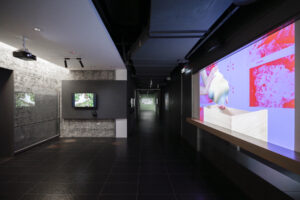
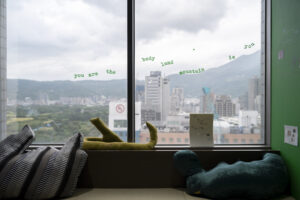
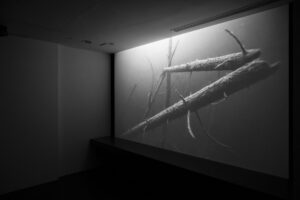
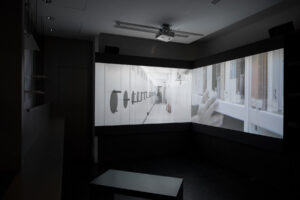




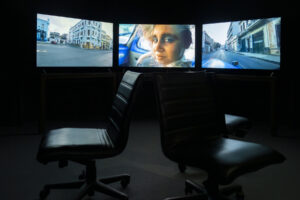

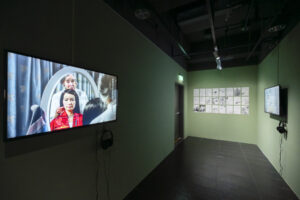
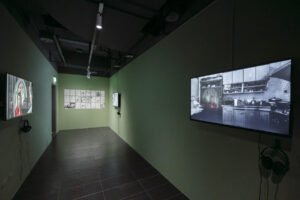
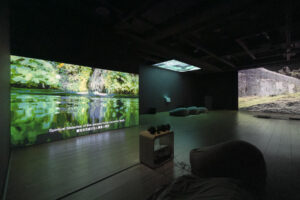
2023 Taiwan International Video Art Exhibition – Living Togetherness
co-curate with Zoe Chia-Jung Yeh, Artists: Tekla Aslanishvili & Giorgi Gago Gagoshidze, Bárbara Sánchez Barroso & Adriana Vila Guevara, Chang Chun-Tzu, Anvar Cheng, George Clark, Anne Fehres & Luke Conroy, Yining Fei, Juliana Höschlová, Elena Knox, Steffen Köhn & Nestor Siré, Lee Eunhee, Esther Lin, Jessi Ali Lin & Chen Hsin-Yu, Lin Jia-Jen, Jane Jin Kaisen, Danila Lipatov, Sasha Litvintseva & Beny Wagner, Anson Hoi Shan Mak, Ana Mendieta, Simon Plouffe, Mark Salvatus, Miku Sato, Su Yu-Hsin, Tang Han, Natasha Tontey, Wang Bo, Rain Wu & Mariana Sanchez Salvador, Aki Yahata, Yuen Nga-Chi, and Zhou Xiao-Peng.
2023.11.03 – 2024.01.28, Hong-gah Museum and Online, Taipei
Living Togetherness, the title of the 8th Taiwan International Video Art Exhibition, revolves around the profound concept of care. The featured artworks thoughtfully respond to this theme by delving into the rich tapestry of human and non-human existence, diverse situations, and locations, all while exploring the intricate web of care that binds these entities together in the scale of deep time.
This artistic showcase delves into the multifaceted meaning of care. Firstly, the aspect of being born together emerges prominently. Each life is intrinsically intertwined with others. How do we as human beings acknowledge these stories of natureculture from an anti-anthropocentric perspective? Some works respond with the calling from the birthplace, the entanglement of material and culture, the interconnection among different spices, revealing the togetherness in the scale of deep time.
Secondly, the exhibition challenges the audience to ponder the essence of life and togetherness in the context of evolving science and technology. The concept of being alive is uniquely embodied across diverse forms of life. Some artworks delve into the distinctions between mere survival and the pursuit of a fulfilling existence. The boundaries between different life forms become subjects of inquiry, urging viewers to nurture curiosity and respect for the inherent unknowability of others. Some works anthropologically document the situatedness of the ethnic minority, women, queer, and non-humans, giving them the space to voice their experiences. Questioning the current knowledge system and listening to the request from the others become the action of care. Some works investigate the preservation and revival of cultural memory through moving-images, emphasizing the significance of caring for and passing down these shared narratives.
Third, Living Togetherness reflects on the dynamics of coexistence in our daily lives. Many featured artworks explore mundane activities such as dietary habits, household chores, companionship, and public interactions. Through art and its power of affecting, the exhibition challenges prevailing knowledge structures, encouraging contemplation of the potential for togetherness within these everyday routines.
In the (post)-COVID time, the record of the hottest July in human history seems not evident to declare the official epoch of the anthropocene, as if the planetary crisis is not felt and embodied enough. Living Togetherness does not advocate for a utopian future; rather, it constitutes a confluence of diverse bodies and lives existing within distinct contexts. Through various modes of perception – seeing, listening, and smelling – the exhibition aspires to attune visitors to a yet undiscovered language, spoken in a realm where all manner of senses, mediums, materials, and bodies coexist harmoniously. In this space, a collective sense of care transcends boundaries, urging us to contemplate and embrace the interconnectedness of all living beings.